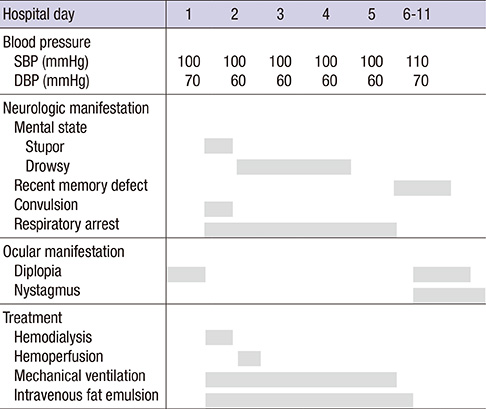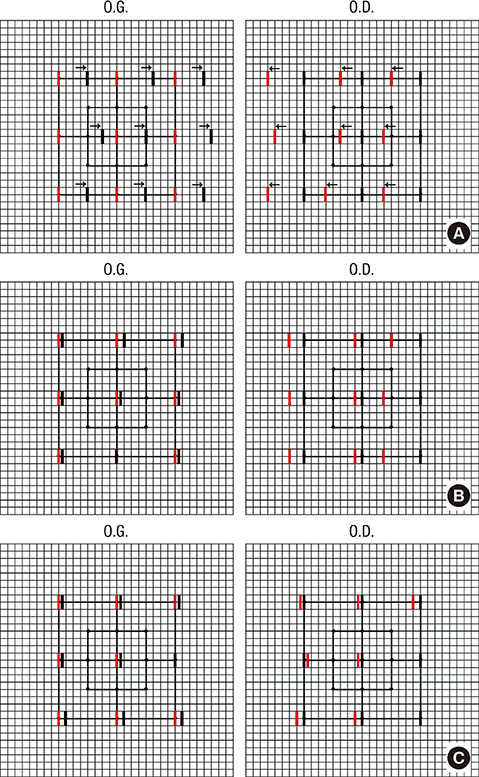J Korean Med Sci.
2013 Nov;28(11):1687-1689. 10.3346/jkms.2013.28.11.1687.
Glufosinate Herbicide Intoxication Causing Unconsciousness, Convulsion, and 6th Cranial Nerve Palsy
- Affiliations
-
- 1Department of Internal Medicine, Soonchunhyang University, College of Medicine, Cheonan, Korea. syhong@sch.ac.kr
- 2Department of Ophthalmology, Soonchunhyang University, College of Medicine, Cheonan, Korea.
- KMID: 1777671
- DOI: http://doi.org/10.3346/jkms.2013.28.11.1687
Abstract
- Although glufosinate ammonium herbicides are considered safe when used properly, ingestion of the undiluted form can cause grave outcomes. Recently, we treated a 34-yr-old man who ingested glufosinate ammonium herbicide. In the course of treatment, the patient developed apnea, mental deterioration, and sixth cranial nerve palsy; he has since been discharged with full recovery after intensive care. This case report describes the clinical features of glufosinate intoxication with a focus on sixth cranial nerve palsy. Our observation suggests that neurologic manifestations after ingestion of a "low-grade toxicity herbicide" are variable and more complex than that was previously considered.
MeSH Terms
Figure
Cited by 1 articles
-
Anterograde Amnesia after Acute Glufosinate Ammonium Intoxication
Hyuk-Hoon Kim, Young-Gi Min
Acute Crit Care. 2018;33(2):110-113. doi: 10.4266/acc.2016.00444.
Reference
-
1. Logusch EW, Walker DM, McDonald JF, Franz JE. Inhibition of plant glutamine synthetases by substituted phosphinothricins. Plant Physiol. 1991; 95:1057–1062.2. Ebert E, Leist KH, Mayer D. Summary of safety evaluation toxicity studies of glufosinate ammonium. Food Chem Toxicol. 1990; 28:339–349.3. Mao YC, Hung DZ, Wu ML, Tsai WJ, Wang LM, Ger J, Deng JF, Yang CC. Acute human glufosinate-containing herbicide poisoning. Clin Toxicol (Phila). 2012; 50:396–402.4. Matsumura N, Takeuchi C, Hishikawa K, Fujii T, Nakaki T. Glufosinate ammonium induces convulsion through N-methyl-D-aspartate receptors in mice. Neurosci Lett. 2001; 304:123–125.5. Park HY, Lee PH, Shin DH, Kim GW. Anterograde amnesia with hippocampal lesions following glufosinate intoxication. Neurology. 2006; 67:914–915.6. Christoff A, Guyton DL. The lancaster red-green test. Am Orthopt J. 2006; 56:157–165.7. Shin MK, Choi CP, Lee MH. A case of herpes zoster with abducens palsy. J Korean Med Sci. 2007; 22:905–907.8. Hermann JS. Isolated abducens paresis complicating herpes zoster ophthalmicus. Am J Ophthalmol. 1962; 54:298–301.9. Gavin C, Langan Y, Hutchinson M. Cranial and peripheral neuropathy due to Epstein-Barr virus infection. Postgrad Med J. 1997; 73:419–420.10. Kishi M, Sakakibara R, Ogawa E, Tateno F, Takahashi O, Koga M. Bilateral abducens palsy in a case of cytomegalovirus-associated Guillain-Barré syndrome. Neurol Sci. 2011; 32:1219–1222.11. Wang CH, Chou ML, Huang CH. Benign isolated abducens nerve palsy in Mycoplasma pneumoniae infection. Pediatr Neurol. 1998; 18:71–72.12. McCormick A, Dinakaran S, Bhola R, Rennie IG. Recurrent sixth nerve palsy following measles mumps rubella vaccination. Eye (Lond). 2001; 15:356–357.13. Werner DB, Savino PJ, Schatz NJ. Benign recurrent sixth nerve palsies in childhood: secondary to immunization or viral illness. Arch Ophthalmol. 1983; 101:607–608.14. Watanabe T, Sano T. Neurological effects of glufosinate poisoning with a brief review. Hum Exp Toxicol. 1998; 17:35–39.15. Koyama K. Glufosinate and a surfactant: which component produces effects on the central nervous system in acute oral BASTA poisoning? Vet Hum Toxicol. 1999; 41:341.16. Koyama K, Koyama K, Goto K. Cardiovascular effects of a herbicide containing glufosinate and a surfactant: in vitro and in vivo analyses in rats. Toxicol Appl Pharmacol. 1997; 145:409–414.17. Song HY, Kim YH, Seok SJ, Gil HW, Yang JO, Lee EY, Hong SY. Cellular toxicity of surfactants used as herbicide additives. J Korean Med Sci. 2012; 27:3–9.18. Song HY, Kim YH, Seok SJ, Gil HW, Hong SY. In vitro cytotoxic effect of glyphosate mixture containing surfactants. J Korean Med Sci. 2012; 27:711–715.19. Kim YH, Hong JR, Gil HW, Song HY, Hong SY. Mixtures of glyphosate and surfactant TN20 accelerate cell death via mitochondrial damage-induced apoptosis and necrosis. Toxicol In Vitro. 2013; 27:191–197.20. Weinberg GL. Lipid emulsion infusion: resuscitation for local anesthetic and other drug overdose. Anesthesiology. 2012; 117:180–187.
- Full Text Links
- Actions
-
Cited
- CITED
-
- Close
- Share
- Similar articles
-
- Associated Injuries and Prognosis in Traumatic Isolated 3rd, 4th, and 6th Cranial Nerve Palsies
- Treatment of Status Epilepticus Following Glufosinate Ammonium Intoxication: A Case Report
- The Etiology and Clinical Feature of the Third, Fourth, and Sixth Cranial Nerve Palsy
- Clinical Considerations of Intoxication Caused by a Herbicide Containing Glufosinate Ammonium: 6 Cases Analysis
- Erythema Multiforme-like Eruptions Caused by Accidental Exposure to Glufosinate Ammonium



